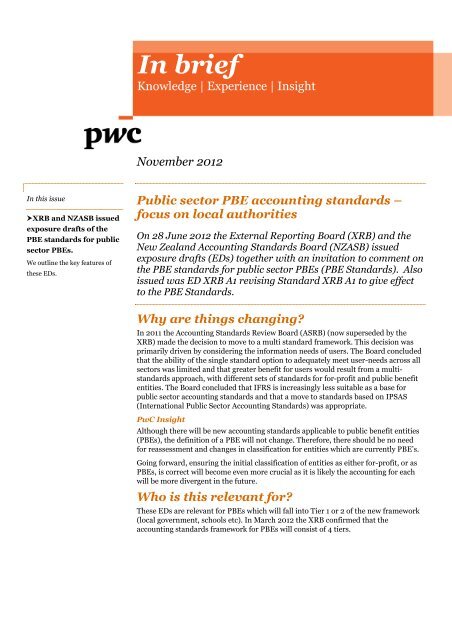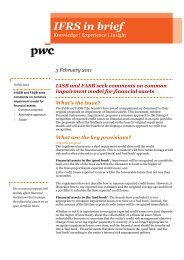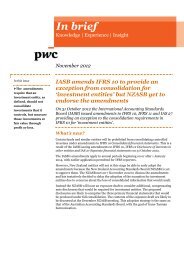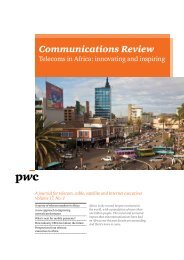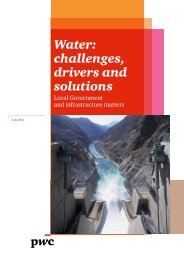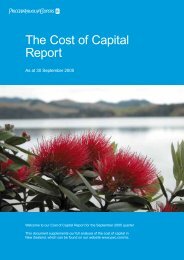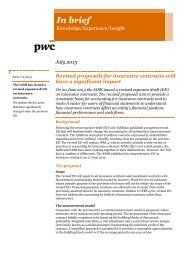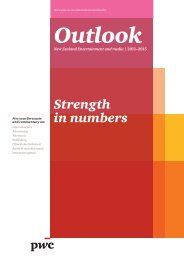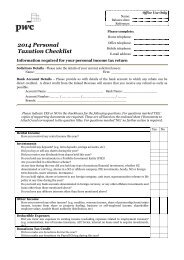You also want an ePaper? Increase the reach of your titles
YUMPU automatically turns print PDFs into web optimized ePapers that Google loves.
<strong>In</strong> <strong>brief</strong><br />
Knowledge | Experience | <strong>In</strong>sight<br />
November 2012<br />
<strong>In</strong> this issue<br />
XRB and NZASB issued<br />
exposure drafts of the<br />
PBE standards for public<br />
sector PBEs.<br />
We outline the key features of<br />
these EDs.<br />
Public sector PBE accounting standards –<br />
focus on local authorities<br />
On 28 June 2012 the External Reporting Board (XRB) and the<br />
New Zealand Accounting Standards Board (NZASB) issued<br />
exposure drafts (EDs) together with an invitation to comment on<br />
the PBE standards for public sector PBEs (PBE Standards). Also<br />
issued was ED XRB A1 revising Standard XRB A1 to give effect<br />
to the PBE Standards.<br />
Why are things changing?<br />
<strong>In</strong> 2011 the Accounting Standards Review Board (ASRB) (now superseded by the<br />
XRB) made the decision to move to a multi standard framework. This decision was<br />
primarily driven by considering the information needs of users. The Board concluded<br />
that the ability of the single standard option to adequately meet user-needs across all<br />
sectors was limited and that greater benefit for users would result from a multistandards<br />
approach, with different sets of standards for for-profit and public benefit<br />
entities. The Board concluded that IFRS is increasingly less suitable as a base for<br />
public sector accounting standards and that a move to standards based on IPSAS<br />
(<strong>In</strong>ternational Public Sector Accounting Standards) was appropriate.<br />
<strong>PwC</strong> <strong>In</strong>sight<br />
Although there will be new accounting standards applicable to public benefit entities<br />
(PBEs), the definition of a PBE will not change. Therefore, there should be no need<br />
for reassessment and changes in classification for entities which are currently PBE’s.<br />
Going forward, ensuring the initial classification of entities as either for-profit, or as<br />
PBEs, is correct will become even more crucial as it is likely the accounting for each<br />
will be more divergent in the future.<br />
Who is this relevant for?<br />
These EDs are relevant for PBEs which will fall into Tier 1 or 2 of the new framework<br />
(local government, schools etc). <strong>In</strong> March 2012 the XRB confirmed that the<br />
accounting standards framework for PBEs will consist of 4 tiers.
The EDs issued will apply to<br />
Tier 1 and 2 public sector<br />
entities only. However, the<br />
expected NFP revisions are<br />
unlikely to change the<br />
substance of the standards,<br />
therefore it is important that<br />
Tier 1 and 2 NFPs also<br />
consider these EDs.<br />
Public sector PBEs are those<br />
which are public entities as<br />
defined by the Public Audit<br />
Act 2001. NFP PBEs are all<br />
other PBEs<br />
The proposed application<br />
date for the PBE standards is<br />
1 July 2014, with<br />
comparatives required for<br />
the earliest period presented.<br />
Tier Tier Criteria Accounting Standards<br />
Tier 1<br />
Tier 2<br />
Tier 3<br />
Tier 4<br />
Publicly accountable PBEs (as defined in<br />
the for-profit framework)<br />
All entities >$30 million expenses<br />
All entities >$2 million expenses and<br />
≤$30 million expenses<br />
All entities ≤$2 million expenses which<br />
are not in Tier 4<br />
Entities allowed to use cash accounting<br />
and which elected to be in Tier 4<br />
Full PBE Accounting<br />
Standards<br />
PBE Accounting Standards<br />
- Reduced Disclosure<br />
Regime (RDR)<br />
PBE Simple Format<br />
Reporting – Accrual basis<br />
PBE Simple Format<br />
Reporting – Cash basis<br />
These latest EDs released by the XRB are the IPSAS-based standards that will apply<br />
to public sector entities in Tiers 1 and 2. Revisions to tailor the PBE standards to<br />
make them more applicable to not-for profits (NFPs) are expected to be released in an<br />
ED in mid-2013, however, these are likely to consist mainly of language and example<br />
amendments. The substance of the PBE Standards is unlikely to change significantly<br />
and therefore these PBE EDs are also important for Tier 1 and 2 NFP entities. An ED<br />
detailing the simple format reporting for Tiers 3 and 4 is expected by the end of the<br />
year.<br />
<strong>PwC</strong> <strong>In</strong>sight<br />
Tier 1 entities include those that are publicly accountable. Under the current financial<br />
reporting framework, local authorities are always publicly accountable due to their<br />
coercive power to tax, rate or levy to obtain public funds. This prevents local<br />
authorities from being able to apply differential reporting concessions. Under the new<br />
framework the definition of publicly accountable, which will result in entities falling<br />
into Tier 1, does not include a requirement for an entity to have a coercive power to<br />
tax, rate or levy to obtain public finds. The definition will be based on the IASB<br />
definition of public accountability (essentially issuers), as well as some entities which<br />
are deemed to be public accountable such as banks and superannuation schemes.<br />
This means some local authorities may fall into Tier 2, or even Tier 3, if their expenses<br />
are less than $30m. Those in Tier 2 will be able to apply RDR rather than the full PBE<br />
Standards.<br />
What has been issued?<br />
The XRB has issued 41 EDs comprising:<br />
<br />
<br />
ED XRB A1 (For-Profit Entities plus Public Sector PBE Update); and<br />
40 ED’s comprising the suite of 39 proposed PBE Standards and a PBE<br />
framework<br />
ED XRB A1<br />
ED XRB A1 is the second stage of development of Standard XRB A1. The first stage<br />
established the suites of accounting standards to be followed by the four tiers of forprofit<br />
entities. The amendments in this ED set out the PBE tier structure, the<br />
accounting standards that apply to the tiers and guidelines for moving between tiers.<br />
It also sets out the proposed application date of the PBE Standards within the other<br />
EDs, being annual reporting periods beginning on or after 1 July 2014 with early<br />
adoption prohibited. This would mean that comparatives prepared in accordance with<br />
PBE Standards would need to be presented for 2013/14 financial year (which will be<br />
different standards to what the financial statements for that year were prepared<br />
under).<br />
<strong>PwC</strong> <strong>In</strong> <strong>brief</strong> Page 2
Conceptual framework<br />
The XRB has issued a PBE framework ED to accompany the PBE Standard EDs. The<br />
<strong>In</strong>ternational Public Sector Accounting Standards Board (IPSASB) does not currently<br />
have a framework for the IPSAS standards, but is working on developing this as a<br />
priority. The XRB felt that a conceptual framework is an essential part of an<br />
accounting standards framework. Therefore it has provided one based on Part B of<br />
the current NZ Framework which applies to PBEs (with minor modifications) as an<br />
interim measure.<br />
PBE Standards<br />
The PBE EDs have been based on IPSAS standards. A number of non-substantive<br />
changes have been made to tailor the language of the IPSAS standards to be more<br />
applicable to public sector and NFP PBEs. There are also a small number of<br />
substantive modifications to reflect the New Zealand context and regulatory<br />
environment. A comparison of the proposed PBE Standard to the original IPSAS is<br />
included at the end of each PBE ED. Where the XRB considered that a topic<br />
important in the New Zealand context was not covered by an IPSAS, the relevant<br />
standard from NZ IFRS has been included with modifications as appropriate for the<br />
PBE environment. Such standards include the NZ IFRS standards on business<br />
combinations, insurance contracts, non-current assets held for sale and discontinued<br />
operations, income taxes, interim financial reporting, prospective financial<br />
statements and summary financial statements.<br />
RDR<br />
The PBE EDs include the reduced disclosure regime for Tier 2 entities (i.e. small local<br />
authorities with less than $30m of expenses). There are no recognition or<br />
measurement differences, but disclosures which may be omitted by Tier 2 entities are<br />
highlighted by an asterix (*) within the PBE EDs.<br />
What are the key differences?<br />
At this point in time, IPSAS (which the proposed PBE standards are based on) and<br />
IFRS are reasonably aligned.<br />
However, there are some differences and these have flowed through into the proposed<br />
PBE Standards. Some of the key differences or likely impacts of PBE standard<br />
adoption from full NZ IFRS highlighted in the XRB’s invitation to comment are:<br />
<br />
<br />
<br />
<br />
The PBE EDs propose a standard on revenue from non-exchange transactions<br />
and a standard on service concession arrangements from a grantor’s<br />
perspective, neither of which are addressed by specific standards under NZ<br />
IFRS. The impact of these will depend on how closely aligned affected<br />
entities’ accounting policies for these types of transactions are to the<br />
proposed standards.<br />
The PBE EDs would not require a Statement of Comprehensive <strong>In</strong>come; only<br />
an <strong>In</strong>come Statement and Statement of Changes in Equity/Net Assets. This<br />
would have a presentation impact only.<br />
The profit or loss on the loss of control, joint control or significant influence<br />
may be measured differently under the PBE EDs.<br />
Scope differences in the proposed associates standard may result in<br />
investments which are treated as associates under NZ IFRS not being<br />
considered associates under the PBE EDs, and therefore not being equity<br />
accounted.<br />
<strong>PwC</strong> <strong>In</strong> <strong>brief</strong> Page 3
Valuations of investment property and PPE would be required to be<br />
undertaken or reviewed by an independent valuer, with disclosures made<br />
regarding these valuations. We would not expect this to have a significant<br />
impact as, until recently, this was also an NZ IFRS requirement. The<br />
measurements objective, being fair value, would remain unchanged.<br />
Under the proposed PPE standard, disclosures would be required in respect<br />
of heritage assets that are not recognised including a description of these<br />
assets and an estimate of their value. Local authorities are likely to be one of<br />
the main entities impacted by this change.<br />
The related party definition in the proposed standard contains differences at<br />
the detailed level, particularly in relation to key management personnel. This<br />
could impact generally on the disclosures entities would be required to make,<br />
and could require new information to be collected about key management<br />
personnel.<br />
The PBE EDs propose two impairment standards – one for cash-generating<br />
assets and one for non-cash generating assets. Under the cash-generating<br />
asset ED some assets currently considered to be impaired under NZ IFRS<br />
may not be impaired due to there being more scope exclusions in the PBE<br />
proposals. Under the non-cash generating asset ED, some non-cash<br />
generating assets not previously assessed as being impaired may in the future<br />
be impaired due to a wider scope for these assets in the PBE proposals than in<br />
NZ IFRS.<br />
The XRB is aware of<br />
constituent concerns about<br />
mixed groups, and has<br />
released an ED to try and<br />
address some of these<br />
concerns with a comment<br />
period that ends on<br />
21 December 2012.<br />
<br />
The PBE EDs propose some clarifications on the treatment of concessionary<br />
loans granted and received, as well as some additional disclosure<br />
requirements.<br />
What about mixed groups?<br />
Local authorities are particularly likely to have to deal with the issue of mixed groups.<br />
These are groups where there is PBE parent, but there are for-profit subsidiaries, or<br />
for local authorities, CCO’s, within the group. This means that the for-profit CCO’s<br />
will be preparing financial statements using different accounting standards to the<br />
parent local authority into which they have to be consolidated.<br />
The XRB is aware of constituent concerns about mixed groups and in the PBE<br />
Standards EDs <strong>In</strong>vitation to Comment noted that it proposed to release a consultation<br />
paper during the comment period for the PBE Standards EDs which would:<br />
<br />
Propose guidance on the application of the phrase ‘like transactions and other<br />
events in similar circumstances’ as an explanation for different accounting<br />
policies resulting from differing requirements in NZ IFRS and PBE Standards<br />
(the IPSAS EDs include the principle that consolidated financial statements<br />
should be based on uniform accounting policies for like transactions and<br />
other events in similar circumstances);<br />
<br />
<br />
Review current differences between the PBE EDs and NZ IFRS and identify<br />
transactions where restatement is likely to be necessary, where restatement is<br />
less likely to be required and where professional judgement would need to be<br />
applied; and<br />
Identify the options that are available to the XRB in considering future<br />
differences between PBE Standards and NZ IFRS.<br />
<strong>PwC</strong> <strong>In</strong> <strong>brief</strong> Page 4
To achieve this, the XRB released in September ED 2012-4 Framework: Public<br />
Benefit Entities – Mixed Groups (together with an invitation to comment). This ED<br />
contains the following proposals:<br />
<br />
<br />
The addition of an Appendix to the proposed PBE IPSAS 6 Consolidated and<br />
Separate Financial Statements providing guidance on the application of the<br />
proposed standard to mixed groups; and<br />
The development of an Explanatory Guide identifying the XRB’s proposed<br />
approach when the IASB issues a new or amended standard prior to the views<br />
of the IPSASB on that standard being known.<br />
Is there guidance on transition?<br />
Of the 39 PBE Standard EDs released, 2 cover transition to the PBE Standards. One<br />
details transition requirements if an entity has previously applied NZ IFRS and the<br />
other details transition requirements for entities other than those previously applying<br />
NZ IFRS.<br />
Entities previously applying NZ IFRS<br />
For those entities currently applying NZ IFRS, the proposal is that entities will be<br />
required to keep the same recognition and measurement policies applied under PBE<br />
Standards as under NZ IFRS, unless these policies do not comply with PBE Standard<br />
requirements. This proposal is designed to limit the ability of entities to change an<br />
option they have selected under NZ IFRS when they transition. However, this would<br />
not limit the ability of an entity to change an accounting policy in the ordinary course<br />
of business where it would meet the requirements set out in the PBE accounting<br />
policy ED (the proposed standard equivalent to NZ IAS 8 Accounting Policies,<br />
Changes in Accounting Estimates and Errors.)<br />
The transitional provisions propose that any restatements of balances or additional<br />
disclosures required as a result of transition occur at the beginning of the earliest<br />
comparative period i.e. at the beginning of the 2013/14 financial year. A third balance<br />
sheet would not be required to be disclosed for entities that previously applied NZ<br />
IFRS.<br />
Where necessary, the transitional provisions include transition guidance specific to<br />
individual proposed PBE Standards.<br />
<strong>PwC</strong> <strong>In</strong>sight<br />
Transition to the proposed PBE Standards should be reasonably straightforward for<br />
those entities currently applying full NZ IFRS. Many of the recognition and<br />
measurement requirements within the proposed PBE Standards are the same as NZ<br />
IFRS. Even if an entity currently applying full NZ IFRS would fall into Tier 2, the<br />
recognition and measurement requirements would be the same as for Tier 1, there<br />
would just be significantly less disclosure required.<br />
A bigger impact of transition would be likely to be felt by those entities currently<br />
reporting under NZ IFRS differential reporting (NZ IFRS diff rep), whether they<br />
would fall into Tier 1 or Tier 2. This is because NZ IFRS diff rep has different<br />
recognition, measurement and presentation requirements to full NZ IFRS. Therefore<br />
on transition to the proposed standards entities that currently report under NZ IFRS<br />
diff rep would have to prepare a cash flow statement for the first time, would not be<br />
able to account for income tax on a taxes payable method and would not be able to<br />
apply tax depreciation rates to their PPE.<br />
<strong>PwC</strong> <strong>In</strong> <strong>brief</strong> Page 5
Entities not previously applying NZ IFRS<br />
For those entities which have not previously<br />
been applying NZ IFRS, the transition<br />
proposal includes all the relevant<br />
requirements and guidance in NZ IFRS 1 First<br />
Time Adoption of New Zealand Equivalents to<br />
<strong>In</strong>ternational Financial Reporting Standards<br />
to ensure that the full range of transactions<br />
and balances of entities transitioning to PBE<br />
Standards would be addressed. For these<br />
entities, a third balance sheet would need to be<br />
disclosed.<br />
What should I do now?<br />
There is no immediate change required in<br />
relation to the preparation of financial<br />
statements. The accounting standards<br />
currently being applied will not change until 1<br />
July 2014. <strong>In</strong> addition, the NZ IFRS standards<br />
which are currently being applied by PBEs are<br />
‘frozen’ as at 1 July 2011, meaning that PBEs<br />
cannot adopt new and amended NZ IFRS’s<br />
such as NZ IFRS 10,11, 12 and 13.<br />
The PBE EDs have the potential to impact<br />
entities in a variety of different ways. It is<br />
important to understand what the proposed<br />
changes are and how they could impact your<br />
organisation. The invitation to comment is a<br />
useful starting point to get an overview of the<br />
If you wish to discuss these or any other<br />
NZ IFRS related matter, please contact<br />
your usual <strong>PwC</strong> contact or one of the<br />
following specialists:<br />
Michele Embling,<br />
Partner, Auckland<br />
michele.j.embling@nz.pwc.com<br />
Mike Schubert<br />
Partner, Auckland<br />
mike.s.schubert@nz.pwc.com<br />
Stephen Hogg<br />
Director, Auckland<br />
stephen.c.hogg@nz.pwc.com<br />
Lyn Hunt<br />
Director, Auckland<br />
lyn.c.hunt@nz.pwc.com<br />
Karen Shires<br />
Partner, Wellington<br />
Karen.f.shires@nz.pwc.com<br />
Robert Harris<br />
Partner, Christchurch<br />
harris.r@nz.pwc.com<br />
XRB’s approach, what’s changing, potential impacts, and what particular issues the<br />
XRB have highlighted for comment. <strong>In</strong> addition, each PBE ED includes an impact<br />
statement at the start which highlights the key differences in that ED to the equivalent<br />
NZ IFRS standard, and what the likely impact of these differences might be (the<br />
invitation to comment also includes a copy of these in the appendix).<br />
All the EDs (including ED XRB A1), invitations to comment and how to submit<br />
comments and submissions can be found here:<br />
http://xrb.govt.nz/Site/Accounting_Standards/Exposure_Drafts/Public_Sector_PBE.aspx<br />
The comment period on these EDs is open until 14 December 2012. The XRB is<br />
happy to take submissions in whichever form is easiest.<br />
Disclaimer: This publication has been prepared for general guidance on matters of interest only, and does not constitute<br />
professional advice. It does not take into account any objectives, financial situation or needs of any recipient; any recipient<br />
should not act upon the information contained in this publication without obtaining independent professional advice. No<br />
representation or warranty (express or implied) is given as to the accuracy or completeness of the information contained in<br />
this publication, and, to the extent permitted by law, PricewaterhouseCoopers, its members, employees and agents do not<br />
accept or assume any liability, responsibility or duty of care for any consequences of you or anyone else acting, or<br />
refraining to act, in reliance on the information contained in this publication or for any decision based on it.<br />
© 2012 PricewaterhouseCoopers. All rights reserved. PricewaterhouseCoopers refers to the network of member firms of<br />
PricewaterhouseCoopers <strong>In</strong>ternational Limited, each of which is a separate and independent legal entity.


